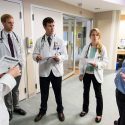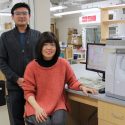Arming the fight against resistant bacteria
In 1928, Alexander Fleming opened the door to treating bacterial infections when he stumbled upon the first known antibiotic in a Penicillium mold growing in a discarded experiment.

Researchers in Helen Blackwell’s lab in the department of chemistry at the University of Wisconsin–Madison demonstrated the potent antibiotic effect of a new compound by applying it in a “motion W” pattern to a dish of live Staphylococcus aureus bacteria. Bacteria killed by the germ-fighting “W” appear white, while the surrounding live bacteria appear red.
Photo: courtesy Helen Blackwell
Nearly eight decades later, chemist Helen Blackwell and her research team at the University of Wisconsin–Madison have devised a more deliberate method to tackle a newer bacterial conundrum – resistance to commonly used antibiotics. Early tests of their tool, called a "small-molecule macroarray," have already identified four promising new compounds with preliminary antibacterial activity comparable to that of some of the most potent antibiotics currently available.
Their findings are reported in the April 27 issue of the journal Chemistry and Biology.
"Dr. Blackwell's research introduces a clever method for rapid screening and offers hope for the discovery of new classes of antibiotics. This is an area of critical importance as bacteria continue to develop resistance faster than scientists are able to develop new drugs to defeat them," says Kenneth M. Doxsee, program officer for the National Science Foundation's organic synthesis program.
Recent rapid development of bacterial resistance against antibiotics has brought bacterial infection back into the limelight as a serious concern, Blackwell says. Virulent strains like methicillin-resistant Staphylococcus aureus, often known as MRSA (pronounced "mir-sa") and once found only in hospitals, have become more common even as the available arsenal of useful drugs against them dwindles.
"Strains are emerging that are resistant to all known antibiotics," she says. "This is not a problem that's going to go away – and actually it's just going to get worse. There's a sense of urgency."
Such urgency is compounded by the speed at which some strains are capable of developing resistance, she adds. For example, bacteria resistant to one of the newest antibiotics, linezolid, appeared within one year of the drug's approval for use.
Since bacteria can adapt to new drugs so quickly, Blackwell says the best approach is to try to stay several steps ahead of the bugs. "No one agent is going to solve this problem," she says. "We need to continue to develop new molecules all the time."
To maximize their chances of finding new compounds with antibacterial activity, Blackwell's group, including graduate students Jennifer O'Neill and Joseph Stringer and former graduate student Matthew Bowman, designed a way to test large numbers of molecules quickly and efficiently.
They synthesize molecules directly on a flexible, paper-like sheet, building from the bottom up by adding ingredients one at a time to sections of the sheet. The finished array has dozens of compounds arranged in a grid of dots, each about the size of a pencil eraser.
They subject each array to a battery of tests, simultaneously testing the potency of each of the compounds against various strains of bacteria, including the dreaded MRSA.

Blackwell
In the end, relatively few pass muster – so far, about two percent – but the ability to synthesize and screen such large numbers of candidates should still allow them to identify large numbers of new possibilities. The whole process of building and testing each batch of 50 to 200 compounds takes less than two days.
The four promising compounds identified so far appear to kill bacteria, at least in a dish, as effectively as several antibiotics currently on the market, Blackwell says, but the most exciting thing about these compounds is that they belong to families of molecules with previously unknown antibiotic potential. By tapping into new chemical families, she says, they have found substances that probably fight bacteria in novel ways – suggesting they may stave off resistance a bit longer.
"These represent whole new classes of antibiotic agents," she says.
Also promising is their finding that, while their most potent compounds were able to kill several clinically relevant bacterial strains, the strongest activity was against MRSA and related strains, known as Gram-positive bacteria.
Finding that these compounds can kill bacteria is a good first step, but it is only one step of many on the long road to drug development, Blackwell says. For now, she will focus on understanding what makes the newly identified infection-fighters tick.
"How do they work?" she asks. "What features of compounds are necessary for activity, and can we improve them?"
Even subtle structural variations can mean the difference between a drug and a dud, but looking at large numbers of related molecules may help the group find clues about which features help battle the bugs. With such information, they can aim to actively tune activity through guided synthesis.
With the new method, "We can gather information on how to improve them fairly quickly," Blackwell says. "Hopefully we will find new approaches for anti-bacterial therapies."
The research is supported by the National Science Foundation, the Shaw Scientist Award Program and the Research Corporation.



